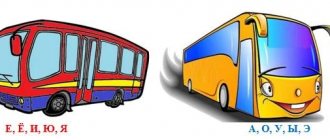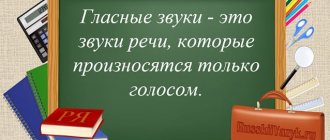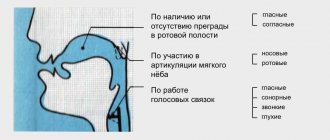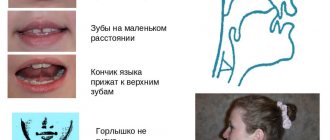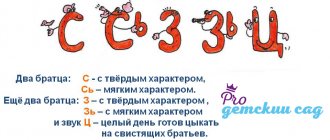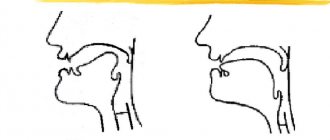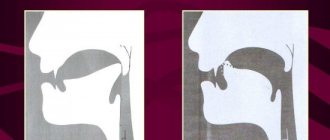- home
- Directories
- Handbook of Russian for elementary school
- Sounds and letters
In spoken language, words are made up of sounds . In written language, words are made up of letters . We pronounce and hear sounds, and we write and see letters (when we read). In writing, sounds are represented by letters.
We also use letters to indicate sounds, but we put them in square brackets. This is a phonetic notation of letters.
For example: sound [m], letter - “em”
The phonetic notation of letters is a transcription . It helps us understand how we speak, reflects the living sound of speech, and teaches us how to pronounce words correctly.
When preparing a transcription, consider:
- it is formatted in square brackets
- each sound corresponds to one sign
- capital letter is not used
- Words must be stressed
- the softness of a consonant is indicated by the symbol [ ' ] - polka - [pol' ka], leaf - [l' source]
- the longitude of a sound is indicated by the symbol [ ¯ ] - it is used when two letters make one sound: quarrel - [quarrel]
Stress placement is very important for correct phonetic notation. Stress, its features and rules of placement in the Russian language are studied by the science of accentology .
There are sounds: vowels and consonants .
The letters are:
- letters denoting vowel sounds (a, o, u and others)
- letters denoting consonants (m, r, k, b and others)
- letters that do not represent sounds (ъ, ь)
The Russian language has more sounds than letters.
To perform phonetic analysis means to characterize all the sounds that make up the word to be analyzed.
Share with friends on social networks:
Vowel sounds
The pronunciation of Russian vowel sounds is different in that the flow of air, when exhaling and pronouncing a particular sound, does not encounter obstacles in the mouth.
Say: “Eeeee.” The sound passes freely, only our voice sounds. There are six vowel sounds in the Russian language: a, o, u, i, ы, e.
These sounds are called ten vowels.
Exercise
Name the vowel sounds in these words, indicate how many vowel sounds there are in the word.
- Brand.
- Life.
- Goal.
- Island.
- Echo.
- Lesson.
- Floor.
- Wolf.
Answer:
- Brand, 2 sounds a.
- Life, 1- and
- Goal, 1st.
- Island, 2 sounds o.
- Echo, 2 sounds - uh, oh.
- Lesson, 2 sounds - u, o
- Paul, 1 –o.
- Wolf, 1 –o.
So, there are six vowel sounds, they are pronounced with one exhalation and without obstacles in the mouth.
Phonetic analysis of the word
Why do you need phonetic analysis of a word?
Phonetic analysis gives the sound characteristics of a word.
With its help, you can break down a word into letters and sounds. Match the number of letters and sounds. And find out the discrepancies between letters and sounds, if any.
What is the order of phonetic parsing?
Phonetic analysis is carried out in the following sequence.
- Indicate the number of syllables and indicate stress.
- Count the number of sounds and letters in a word.
- Describe vowel sounds: stressed/unstressed.
- Describe consonant sounds: voiced/voiceless, hard/soft.
What is the alphabet?
Do you hear the song coming from the island? Let's listen to her. What are the residents singing about?
How interesting this is. It's time to explore the surroundings. And here is a map of the island.
This map is not easy
This is the Russian ALPHABET!
He will put the letters in their places.
And order reigns in it.
Everyone needs to know the alphabet
Study together at school!
What an amazing island! Perhaps we need to learn the entire alphabet; knowing the letters will help us develop the ability to read.
Exercise
Look at the picture above, remember or count: how many letters are in the Russian alphabet?
Answer: 33 letters.
Let's walk around the island. Here it is written how the Russian alphabet originated.
How interesting! But we need to ask residents to tell us about this story in even more detail. Someone is coming towards us, it looks like the letter A!
Now guys, listen to the story associated with the appearance of the alphabet, the oldest resident of the city, Az, will tell it to us.
The Tale of the Alphabet
Great learned men appeared on Russian soil who wanted to make our state glorious and powerful. These were the monk brothers Cyril and Methodius. They chose a noble path - to make Russian people smart, to teach everyone to read and write. And before them there was no single order of letters. Taking the Greek alphabet as a basis, the brothers did a great job.
They were able to arrange all the letters. This is how the Glagolitic alphabet appeared - the first alphabet, derived from the word “verb” - to speak.
And then they made it even simpler and called it Cyrillic. 43 letters are included in this alphabet. And each letter was highlighted and given its name. The first letters were named Az, Buki - this is how the word ABC appeared.
This alphabet has changed for several centuries. Has gone through many reforms. And now we have a completely new, but very convenient alphabet that every child should know.
Glory to the alphabet! Thank you, Cyril and Methodius, for your invaluable gift to people.
Did you know that all books used to be written by hand! They were written by monks, carefully writing each letter. Such a book took a year to write, and sometimes even longer. We would not even be able to distinguish a written book from a printed one, because it was written in compliance with all the rules of style. The creators of books were called chroniclers. They were extraordinarily talented and hardworking. The first creators of handwritten books had to show a lot of strength and patience.
But soon Ivan Fedorov became the founder of book printing. Printed books appeared. They were created for training. Later, secular books began to be published, which were purchased by noble and wealthy people. Much time has passed since then, books have become an everyday item and have become a part of our lives.
Currently, all letters have two styles: printed and capital. Capital letters of the Russian alphabet are necessary for fast writing. Block letters are used in books and other publications. At the same time, teaching expressive reading occurs with the help of printed letters.
In first grade, you will develop the ability to read and write capital letters.
This skill is very important for every person. After all, writing block letters takes a long time and is completely inconvenient. Having mastered a wonderful way of writing quickly, you will cope with rewriting any text much faster. This path is difficult and will require diligence and effort. That is why every person develops his unique handwriting.
§236. Pronunciation of some consonants
1. The consonant [g] in literary pronunciation is explosive, instant sounding, and when deafened, is pronounced as [k]: sn[k], bere[k]. g in its place , conventionally designated [ h ], does not correspond to the norm: [ h]ulya ́t, sapo[ h]i ́. The exception is the word God, at the end of which there is an [x].
2. Instead of h in the words of course, boring, scrambled eggs, trifling, birdhouse, bachelorette party, laundry, rag, rag-picker, in female patronymics ending in - and chna ( Nikitichna, Kuzminichna, Ilyinichna , etc.), as well as in the words that, in order, nothing is pronounced [sh] .
3. In the words man, defector in the place of the combination zhch , in the form of the comparative degree of adverbs tougher, harsher (and biting ) in the place stch , and also in the place of the combinations zch and sch it is pronounced [sch]: loader, customer, carver, subscriber, sandstone , happy, happiness, account, electronic counting, counter, self-financing, count, etc.
4. When several consonants accumulate in some combinations, one of them is not pronounced:
a) in combination stn is not pronounced [t]: ucha ́[s'n']ik, ve ́[s']nik, che ́[sn]y, me ́[sn]y, famous ́[sn]y, nena ́[sn]y, I ́ro[s]y;
b) in the combination zdn is not pronounced [d]: po ́[zn]o, pra ́[zn]ik, nae ́[zn]ik, but in the word abyss it is recommended to leave a weak sound [d];
c) in the combination stl, [t] is not pronounced scha [ s'l ']i ́vyy, envious ́[s'l']ivy, so ́ve[s'l']ivy; in the words bony and postlat [t] is preserved;
d) in combination stl, [t] is not pronounced in this case, a double consonant [ss] is formed: maximali ́[ss]kiy, turi ́[ss]kiy, rasi ́[ss]kiy.
5. In some words, with the accumulation of consonant sounds stk , zdk, ntk, ndk, [t] is not allowed daughter-in-law, trip, agenda, typist, bulky, laboratory assistant, student, patient, Irish, tartan, but: cloth shotla [ nc ] A.
6. Hard consonants before soft consonants can be softened:
a) it is necessarily softened before soft z and s: pe ́[n's']iya, prete ́[n'z']iya, rece ́[n'z']iya, face ́[n'z'] and I;
b) in combinations tv , dv can be softened t and d : Thursday, Tver, hard [t'v'] and [tv']; door, two, move [d'v] and [dv'];
c) in combinations of sound and sv z and can be softened : beast, ring [z'v'] and [zv']; light, candle, witness, holy [s'v] and [sv'], as well as in the word snake [z'm'] and [zm'];
d) n before soft t i d softens: ba[n't']ik, vi[n't']ik, zo[n't']ik, ve[n't']il, a[n' t']ichny, ko[n't']text, remo[n't']irovat, ba[n'd']it, I[n'd']iya, stip[n'd']iya, zo[n'd']irovat, i[n'd']ivid, ka[n'd']idat, blo[n'd']in.
↑ Contents ↑
§238. Peculiarities of pronunciation of Russian names and patronymics
The combination of first name and patronymic is used in various situations, both in written and oral speech: in official decrees on awards, appointments, orders, lists, for example, on personnel records, the composition of production and educational groups, in business and private correspondence, in circulation to the interlocutor, in introducing and naming third parties.
In an environment of official, business communication between people, especially in the work of a teacher, translator, editor, lawyer, businessman, government or commercial employee, there is a need to address people by name and patronymic. Many Russian names and patronymics have pronunciation options that it is advisable to take into account in a given communication situation. So, when meeting a person, when introducing a person for the first time, a distinct, clear pronunciation that is close to the written form is recommended.
In all other cases, incomplete, contracted forms of pronunciation of names and patronymics, which have historically developed in the practice of literary oral speech, are acceptable.
1. Patronymics formed from male names starting with -i ( Vasily , Anatoly, Arkady, Grigory, Yuri, Evgeniy, Valery, Gennady ) end in the combinations -evich , -evna with a preceding separator ь : Vasilevich , Vasilevna ; Grigor'evich , Grigor'evna . _ When pronouncing female patronymics, these combinations are clearly preserved: Vasil evna , Anatoly evna , Grigory evna , etc. In male patronymics, full and contracted variants are allowed: Vasya ́[l' jв']ich and Vasily[l'ich], Anato ́[l' jьv']ich and Anato ́[l'ich], Grigo ́[р' jьв ']ich and Grigo ́[r'ich] , etc.
2. Patronymics formed from male names ending in -e y and -ay ( Aleksey, Andrey, Korney, Matvey, Sergey, Nikolay ) end in the combinations -eevich, -eevna, -aevich, -aevna: Alekseevich, Alekseevna, Nikolaevich, Nikolaevna . In their pronunciation, the literary norm allows both full and contracted variants: Alekse ́evich and Alekse ́[i]ch, Alekse ́evna and Alek[s'e ́]vna; Sergeevich and Serge ́[i]ch, Serge ́evna and Ser[g'e ] vna; Korneevich and Korne ́[i]ch, Korne ́evna and Kor[n'e ́ ]vna; Nikola ́evich and Nikola ́[i]ch, Nikola ́evna and Nikola ́[vn]a , etc.
3. Male patronymics ending in an unstressed combination -o vich can be pronounced both in full and contracted form: Anto ́novich and Anto ́n[y]ch, Alexa ́ndrovich and Alexa ́ndr[y]ch, Iva ́novich and Ivan ́n [y]h , etc. In female patronymics ending in the unstressed combination -o vna, full pronunciation is recommended: Alexander ovna, Boris ovna, Kirill ovna, Victor ovna, Oleg ovna , etc.
4. If the patronymic begins with and ( Ivanovich, Ignatievich, Isaevich ), then when pronounced with a name ending in a hard consonant, it turns into [s]: Pavel Ivanovich - Pavel[y]vanovich, Alexander Isaevich - Alexander[y]saevich .
5. Usually ov in female patronymics from names ending in n i m: Iva ́[n:]na, Anto ́[n:]a, Efi ́[mn]a, Maxi ́[n:]a.
6. -o in female patronymics from names ending in v is not pronounced Vyachesla ́[vn]a, Stanisla ́[vn]a.
↑ Contents ↑
§2. Transcription
Transcription is a special recording system that displays sound. The following symbols are used in the transcription:
[ ] – square brackets indicating transcription.
[ ´] – emphasis. The accent is placed if the word consists of more than one syllable.
[b'] – the icon next to the consonant indicates its softness.
[j] and [th] are different designations for the same sound. Since this sound is soft, these symbols are often used with an additional designation of softness: [j'], [th']. This site uses the notation [th'], which is more familiar to most guys. The soft icon will be used to help you get used to the sound being soft.
There are other symbols. They will be introduced gradually as you become familiar with the topic.
Morphological principle of spelling
Why does an ordinary person, far from linguistics, need to know the strong and weak positions of vowel and consonant phonemes? The fact is that the spelling of 90% of Russian words is regulated by the so-called morphological principle . According to him, we should not take into account phonetic alternations when we pick up a pen or type text on a keyboard. Roots, suffixes, prefixes, endings are always written the same way. Reduction of vowels, softening of consonants before certain sounds, their voicing or deafening are not taken into account.
From this follows the conclusion: when writing, you cannot rely on hearing. Only sounds in strong positions are written as they are heard. All others need to be verified. Having determined that the phoneme is in a weak position, we begin to select a test word with the same morpheme. For example, a tooth is a tooth, a linden tree is a pine tree, a hike is a train, to a lamp is to water. In the test word, the phoneme must be in a strong position, and be in the same morpheme. Otherwise you might make a mistake.
§237. Pronunciation of individual grammatical forms
Some grammatical forms of verbs, nouns, and adjectives are characterized by special rules for the pronunciation of sounds in suffixes and endings.
1. In verbs with the particle -с I in the indefinite form and in the third person singular and plural, at the junction of the ending and the particle, [ts] is pronounced: meet, meet meet ́ti [ts], mark, mark – mark ́ti [ts], to check in - mark ́[ts], to say goodbye - farewell ́[ts].
In the form of the imperative mood, at the place of the combination -t'sya , two soft sounds [t's''] sound: mark - mark [t's''], meet - wind ́ [t's''].
2. At the endings of the genitive case of the masculine and neuter forms of adjectives, numerals, pronouns -о go/-е in place of g it is pronounced [в]: big house (lake) – big ́[вь], blue flag (sea) – с ́не [v]. The same rule applies to the words today - se[v]o ́, total - ito [v]o ́.
| Note. In surnames ending in -a go ( Shembinago , Zhivago ), the sound [g] is pronounced. |
3. Graphic abbreviations found in the text, for example, initials with a surname, as well as abbreviations such as l (liter), m (meter), kg (kilogram), ha (hectare), p/y (“mailbox”), t .d. (etc.), with (page), etc. in reading are “deciphered”, i.e. “unfold” into full words. Graphic abbreviations exist only in written speech for visual perception only, and their literal reading is perceived either as a speech error or as irony, appropriate only in special situations.
↑ Contents ↑

